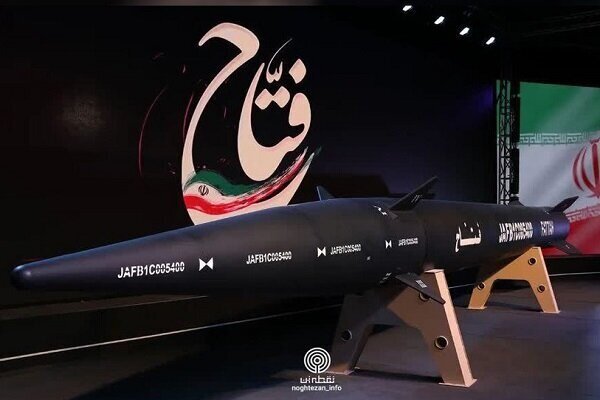Hypersonic option
Fattah, Iran's first hypersonic missile, unveiled in the presence of Raisi

TEHRAN – In a historic move, Iran joined the limited club of countries possessing hypersonic missiles amid American pressure and snowballing tensions with Israel.
After days of media speculations, Iran formally unveiled its first domestically built hypersonic missile in a ceremony attended by Iranian President Ebrahim Raisi and a number of high-ranking military officials, including IRGC Aerospace Force Commander Brigadier General Amir Ali Hajizadeh.
The missile, named Fattah by Ayatollah Seyed Ali Khamenei, is the latest state-of-the-art projectile in the Iranian missile arsenal. It has a spherical engine running on solid fuel with a movable nozzle that allows the missile to move in all directions, according to Tasnim.
With a range of 1,400 kilometers, Fattah can complicate the functionality of any type of missile defense system. General Hajizadeh said the homegrown hypersonic ballistic missile has undergone all tests.
The new missile can penetrate all air defense missile systems and detonate the enemy’s anti-missile systems, he added.
Describing the production of the projectile as a “huge leap” in Iran’s missile industry, the commander said the missile can maneuver below and above the Earth’s atmosphere at a speed of Mach 13.
The new unveiling comes against a backdrop of continued U.S. efforts to “contain” Iran in light of Washington’s unilateral withdrawal from the 2015 nuclear deal, which prompted Iran to resume some of its nuclear activities.
Ironically, the U.S. withdrawal from the nuclear deal, officially called the Joint Comprehensive Plan of Action (JCPOA), was in part meant to curb Iran’s missile program. Former U.S. President Donald Trump cited Iran’s missile progress as one of the reasons for his administration’s illegal withdrawal from the JCPOA. Then the U.S. re-imposed blanket economic sanctions on Iran to push it into acquiescing to U.S. demands. But U.S. pressures failed to achieve the desired goals. And what the U.S. feared most became a reality.
Fattah is a case in point. With this missile, Iran made a great stride in ballistic missile technology.
Despite U.S. pressures and sanctions, Iran is making significant progress. Fattah is a new disaster for many bragged-about Western missile defense systems. Iranian media said on Tuesday that the new missile can penetrate any such systems. Tasnim described it as the “killer” of missile defense systems.
In a sense, the Fattah missile is a response to recent threats by Israel and the U.S., which have stepped up their bluster against Iran. In recent weeks, the Israeli regime officials went so far as to vow to surprise Iran, with U.S. officials missing no opportunity to remind Iran of the all-options-are-on-the-table dross.
But Fattah indicated that Iran may have many options to put on the table. It’s no coincidence that the Leader of the Islamic Revolution chose the name of Fattah for this missile, which means “problem-solver.” At the end of the day, Fattah can make the enemies think twice before committing aggression against Iran.
Speaking at the unveiling ceremony, President Raisi said Iran now enjoys deterrence. “Today, we feel that the power of deterrence has been created and this power is a point of security and stable peace for the countries of the region,” he said.
Highlighting Iran’s great progress and independence in the defense industries, the president said Iran’s military know-how, science and industries, including the missile power, are indigenous, not imported, so the enemies are unable to marginalize these capabilities with threats.
General Hossein Salami, the chief commander of the Islamic Revolution Guards Corps (IRGC), said the technology employed in Fattah is not known to many countries. “This technology is unknown to most countries of the world, but the committed specialists of our country have achieved it,” he said.
He added that Iran has become one of the four countries to possess this technology. General Salami noted that Fattah is a hypersonic maneuverable missile that can change direction in space and defeat anti-missile defense systems, according to Tasnim.
He also noted that Iran’s leaps and advances in the defense sector, including the missile and drone industries, have been made with the use of advanced technologies such as artificial intelligence and technical capabilities in manufacturing sensitive and high-tech components.
Leave a Comment